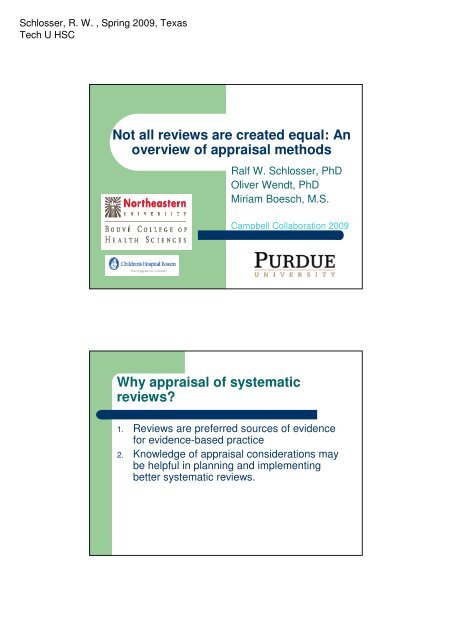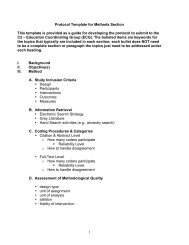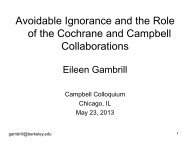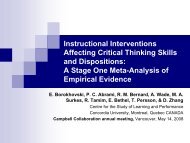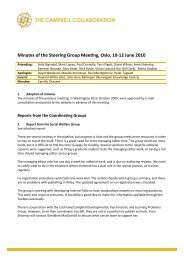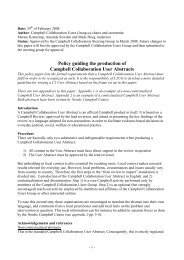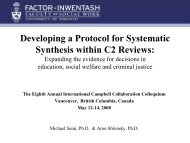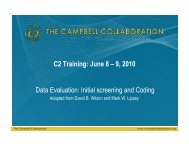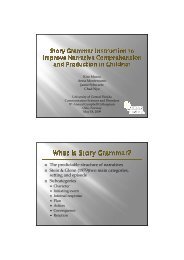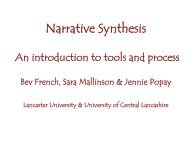EVIDAAC Systematic Review Scale - The Campbell Collaboration
EVIDAAC Systematic Review Scale - The Campbell Collaboration
EVIDAAC Systematic Review Scale - The Campbell Collaboration
Create successful ePaper yourself
Turn your PDF publications into a flip-book with our unique Google optimized e-Paper software.
Schlosser, R. W. , Spring 2009, Texas<br />
Tech U HSC<br />
Not all reviews are created equal: An<br />
overview of appraisal methods<br />
Ralf W. Schlosser, PhD<br />
Oliver Wendt, PhD<br />
Miriam Boesch, M.S.<br />
<strong>Campbell</strong> <strong>Collaboration</strong> 2009<br />
Why appraisal of systematic<br />
reviews?<br />
1. <strong>Review</strong>s are preferred sources of evidence<br />
for evidence-based practice<br />
2. Knowledge of appraisal considerations may<br />
be helpful in planning and implementing<br />
better systematic reviews.
Schlosser, R. W. , Spring 2009, Texas<br />
Tech U HSC<br />
Goals for today<br />
� Provide an overview of appraisal considerations<br />
� Schlosser, R. W., Wendt, O., & Sigafoos, J. (2007). Not all<br />
systematic reviews are created equal: considerations for<br />
appraisal. Evidence-Based Communication Assessment and<br />
Intervention, 1, 138-150.<br />
� Learn of different methods and tools for appraising<br />
reviews<br />
� Evidence in Augmentative and Alternative Communication<br />
(<strong>EVIDAAC</strong>)<br />
� Evidence-based Communication Assessment and<br />
Intervention<br />
� ASHA EBP Compendium<br />
Criteria for Appraising <strong>Review</strong>s<br />
(Jackson, 1980; White, 1994)<br />
1. Previous reviews need to be described and<br />
distinguished from the current review<br />
2. <strong>The</strong> topic has to be carefully defined and delimited<br />
3. <strong>The</strong> procedures for obtaining studies must be<br />
detailed<br />
A. Domain notes<br />
B. Scope notes<br />
C. Selection principles notes
Schlosser, R. W. , Spring 2009, Texas<br />
Tech U HSC<br />
3A. Domain Notes<br />
� Domain notes refer to all the sources used to identify the<br />
studies, including sources that failed to yield items.<br />
– General-purpose databases<br />
– Search engines<br />
– Journals<br />
– Bibliographies<br />
– Trials registers<br />
– Conference proceedings<br />
– Book chapters, books,<br />
– Grey literature, etc.<br />
3A. Domain Notes<br />
“Studies for this review were collected by hand and<br />
electronic searches. An initial search was conducted<br />
using electronic databases (MEDLINE, CINAHL, ERIC,<br />
Exceptional Child Education Resources, Linguistics and<br />
Language Behavior Abstracts, PsycINFO) and books<br />
appropriate to the topic. Reference lists of all studies<br />
retrieved from the electronic and hand searches were<br />
reviewed for additional studies. <strong>The</strong> main source for the<br />
identified studies came from journals and papers<br />
presented at professional meetings” (Schwartz & Nye,<br />
2006, p. 3-4).
Schlosser, R. W. , Spring 2009, Texas<br />
Tech U HSC<br />
� Source selection bias<br />
3A. Domain Notes<br />
– Several complementary sources fully described (not<br />
only computer searches)<br />
– Out of 95 included studies, 28 studies were found<br />
through means other than searching of databases<br />
(Wendt et al., 2005).<br />
– Database bias:<br />
� Medline coverage (Dickersen et al., 1994; Hyung Bok Yoo &<br />
Quebuz, 2004).<br />
� Source biases<br />
3A. Domain Notes<br />
– Publication bias (Egger & Smith, 1998)
Schlosser, R. W. , Spring 2009, Texas<br />
Tech U HSC<br />
3A. Domain Notes<br />
“<strong>The</strong> search strategies were thorough, well rationalized, and fairly<br />
comprehensive; nevertheless the number of studies that met<br />
the inclusion criteria was low and few were recent. It is<br />
possible the additional searches of unpublished literature such<br />
as theses and conference papers may have unearthed more<br />
studies that included some with more rigorous methodologies.<br />
This would have allowed the investigators to examine whether<br />
there is a publication bias with respect to this question<br />
(Rothstein, Sutton, & Borenstein, 2005). It is possible that<br />
studies which show negative effects of AAC interventions on<br />
speech production do not get published as often as do studies<br />
that do show an effect” (Balandin, 2008, p. 5; appraisal of<br />
Millar, Light, & Schlosser, 2006)<br />
� Search terms used<br />
� Geographic constraints<br />
� Temporal constraints<br />
� Language constraints<br />
3B. Scope Notes<br />
� “It is thus clear that linguistic exclusion criteria, in addition to<br />
being incompatible with the principle of ‘systematic overview of<br />
the totality of the evidence from all relevant unconfounded<br />
randomized trials’, can be a source of error. This source of error<br />
is much easier to control than the exhaustive search for<br />
unpublished research which authors of meta-analyses are<br />
supposed to do in order to at least partially control for publication<br />
bias” (Grégoire et al., 1995, p. 161).
Schlosser, R. W. , Spring 2009, Texas<br />
Tech U HSC<br />
3C. Selection Principle Notes<br />
� Include any kind of editorial criteria used in<br />
accepting or rejecting studies to be reviewed<br />
� Type of design<br />
� Examples of studies with rationales as to why they were<br />
included or excluded<br />
– <strong>The</strong> content criteria for inclusion and exclusion are appropriate<br />
and fully stated<br />
– Log of rejected trials<br />
� How were decisions on the relevance of original studies<br />
made?<br />
Criteria for Appraising <strong>Review</strong>s<br />
4. <strong>The</strong> degree to which the studies share the same<br />
dependent and independent variables must be reported<br />
5. <strong>The</strong> process of data extraction from the original studies is<br />
clearly delineated<br />
A. What?<br />
� Coding categories extracted from studies are listed and defined<br />
B. Who?<br />
C. How?<br />
� Data extracted by more than one observer, blinded to the treatment<br />
groups, blinded to the results (Cook et al., 1977)<br />
� How are disagreements being dealt with?
Schlosser, R. W. , Spring 2009, Texas<br />
Tech U HSC<br />
Criteria for Appraising <strong>Review</strong>s<br />
6. <strong>The</strong> criteria used to arrive at judgments of effectiveness<br />
should be stated<br />
7. <strong>The</strong> criteria used to arrive at judgments of quality should<br />
be stated:<br />
A. Design<br />
B. Treatment integrity<br />
C. Blinding<br />
D. Reliability<br />
8. <strong>The</strong> co-variation of study outcomes with study<br />
characteristics must be examined<br />
– Study outcomes: Effect sizes<br />
– Study characteristics: Gender, age, quality indicators<br />
Tools for Appraising <strong>Review</strong>s<br />
� A project funded by the Agency of Healthcare Research<br />
and Quality evaluated 20 existing tools for appraising<br />
reviews, and arrived at two that met key quality criteria<br />
– West, S., King, V., Carey, T. S., et al. Systems to Rate the<br />
Strength of Scientific Evidence. Evidence Report/Technology<br />
Assessment No. 47 (Prepared by the Research Triangle Institute-<br />
University of North Carolina Evidence-based Practice Center<br />
under Contract No. 290-97-0011). AHRQ Publication No. 02-<br />
E016. Rockville, MD: Agency for Healthcare Research and<br />
Quality. April 2002.
Schlosser, R. W. , Spring 2009, Texas<br />
Tech U HSC<br />
Tools for Appraising <strong>Review</strong>s Cont’d<br />
� Two tools met their criteria<br />
– Auperin, A., Pignon, J.-P., & Poynard, T. (1997). <strong>Review</strong> article:<br />
critical review of meta-analyses of randomized clinical trials in<br />
hepatogastroenterology. Aliment Pharmacological <strong>The</strong>rapy, 11,<br />
215-225.<br />
– Sacks, H. S., Reitman, D., Pagano, D., & Kupelnick, B. (1996).<br />
Meta-analysis: An update. <strong>The</strong> Mount Sinai Journal of Medicine,<br />
63, 216-224.<br />
Appraisal of <strong>Review</strong>s in <strong>EVIDAAC</strong>: Evidence<br />
in Augmentative and Alternative<br />
Communication<br />
� Schlosser, R. W., Raghavendra, P., Sigafoos, J. and the<br />
<strong>EVIDAAC</strong> team (2008). <strong>EVIDAAC</strong> <strong>Systematic</strong> <strong>Review</strong><br />
<strong>Scale</strong>. Manuscript in preparation.*<br />
� *This project was in part supported by a Field-Initiated<br />
Development Grant from the National Institute on Disability and<br />
Rehabilitation Research (NIDRR), U.S. Department of Education<br />
(#H133G070150-08) to Ralf W. Schlosser. <strong>The</strong> authors,<br />
however, bear sole responsibility for the content; funding by<br />
NIDRR does not imply that the content is endorsed by the<br />
agency.<br />
� http://www.evidaac.org<br />
� http://www.evidaac.com
Schlosser, R. W. , Spring 2009, Texas<br />
Tech U HSC<br />
Appraisal Item Rating<br />
1. <strong>The</strong> review addresses a clearly focused question? (e.g., was<br />
there enough information on the population studied, the<br />
intervention given, the outcomes considered?)<br />
p. ( ):<br />
Rationale:<br />
2. <strong>The</strong> search methods were pre-defined.<br />
p. ( ):<br />
Rationale:<br />
3. Multiple complementary sources that collectively minimize<br />
source selection bias are consulted (Consider databases, hand<br />
searches, ancestry searches, contacting authors, forward citation<br />
searches).<br />
p. ( ):<br />
Rationale:<br />
4. An attempt was made to locate unpublished studies (e.g., trial<br />
registers, dissertations, etc.)<br />
p. ( ):<br />
Rationale:<br />
5. Databases are carefully selected so that they, together, minimize<br />
the potential of systematically excluding studies.<br />
p. ( ):<br />
Rationale:<br />
6. <strong>The</strong> search terms are stated and appropriate for each database.<br />
p. ( ):<br />
Rationale:<br />
7. <strong>The</strong> criteria for inclusion and exclusion of studies are predefined.<br />
p. ( ):<br />
Rationale:<br />
Yes<br />
No<br />
Yes<br />
No<br />
Yes<br />
No<br />
Yes<br />
No<br />
Yes<br />
No<br />
Yes<br />
No<br />
Yes<br />
No
Schlosser, R. W. , Spring 2009, Texas<br />
Tech U HSC<br />
8. <strong>The</strong> criteria for inclusion and exclusion are appropriate given the<br />
purpose of the review.<br />
p. ( ):<br />
Rationale:<br />
9. A log of rejected studies is reported/available upon request.<br />
p. ( ):<br />
Rationale:<br />
10. A reasonable percentage of studies (=/> 20%) is evaluated reliably<br />
for inclusion by more than one rater.<br />
p. ( ):<br />
Rationale:<br />
11. Coding categories for data extraction are pre-defined.<br />
p. ( ):<br />
Rationale:<br />
12. At least a 20% sample of the data are extracted reliably by more than<br />
one rater (blinded to the treatments, if applicable)<br />
p. ( ):<br />
Rationale:<br />
13. Criteria used to arrive at judgments of quality are pre-defined and<br />
appropriate for the types of included designs.<br />
p. ( ):<br />
Rationale:<br />
14. Methods used to arrive at judgments of effectiveness for each study are<br />
pre-defined and operationalized.<br />
p. ( ):<br />
Rationale:<br />
15. <strong>The</strong> outcomes are relevant<br />
p. ( ):<br />
Rationale:<br />
16. <strong>The</strong> outcomes are objective<br />
p. ( ):<br />
Rationale:<br />
Yes<br />
No<br />
Yes<br />
No<br />
Yes<br />
No<br />
Yes<br />
No<br />
Yes<br />
No<br />
Yes<br />
No<br />
N/A<br />
Yes<br />
No<br />
N/A<br />
Yes<br />
No<br />
N/A<br />
Yes<br />
No
Schlosser, R. W. , Spring 2009, Texas<br />
Tech U HSC<br />
17. <strong>The</strong> outcomes are homogenous.<br />
p. ( ):<br />
Rationale:<br />
18. Confidence intervals are supplied for individual studies and pooled<br />
results.<br />
p. ( ):<br />
Rationale:<br />
19. A sensitivity analysis is conducted with varying end-points (i.e.,<br />
outcomes) and statistical methods or with exclusion of some studies.<br />
p. ( ):<br />
Rationale:<br />
20. <strong>The</strong> co-variation between pre-defined study or participant<br />
characteristics and treatment outcomes is examined.<br />
p. ( ):<br />
Rationale:<br />
Total Number of “Yes” Responses<br />
Total Number of “No” Responses<br />
Total Number of “NA” Responses<br />
<strong>EVIDAAC</strong> <strong>Systematic</strong> <strong>Review</strong> <strong>Scale</strong><br />
N/A<br />
Yes<br />
No<br />
N/A<br />
Yes<br />
No<br />
N/A<br />
Yes<br />
No<br />
N/A<br />
Yes<br />
No<br />
1. <strong>The</strong> review addresses a clearly focused question?<br />
(e.g., was there enough information on the population<br />
studied, the intervention given, the outcomes<br />
considered?)<br />
Definition: Consider the examples in parenthesis to arrive at<br />
your rating. A focused question will define not only the<br />
population but also the intervention and targeted outcomes.<br />
If even one of these is missing, mark “No”
Schlosser, R. W. , Spring 2009, Texas<br />
Tech U HSC<br />
<strong>EVIDAAC</strong> <strong>Systematic</strong> <strong>Review</strong> <strong>Scale</strong><br />
2. <strong>The</strong> search methods were pre-defined.<br />
Definition: <strong>The</strong> “search methods” refers to the sources<br />
consulted as well as the search strategies (e.g. use of<br />
keyword searches, handsearches, etc.). “Pre-defined”<br />
means “apriori” or that the search methods are explained<br />
upfront before the authors report on included studies and<br />
results (rather than as an after thought when the authors<br />
mention in the discussion section that they searched a<br />
particular database which had not been mentioned in the<br />
Methods section).<br />
<strong>EVIDAAC</strong> <strong>Systematic</strong> <strong>Review</strong> <strong>Scale</strong><br />
3. Multiple complementary sources that collectively<br />
minimize source selection bias are consulted<br />
(Consider databases, hand searches, ancestry<br />
searches, contacting authors, forward citation<br />
searches).<br />
Definition: Source selection bias might occur when the<br />
mix of consulted sources is inadequate to minimize<br />
the potential for bias. For example, reliance on<br />
databases only in absence of other sources would<br />
render a “no” response.
Schlosser, R. W. , Spring 2009, Texas<br />
Tech U HSC<br />
<strong>EVIDAAC</strong> <strong>Systematic</strong> <strong>Review</strong> <strong>Scale</strong><br />
4. An attempt was made to locate unpublished studies<br />
(e.g., trial registers, dissertations, etc.)<br />
Definition: As part of the description of search methods, the<br />
authors may describe that they aimed to locate unpublished<br />
studies and how they went about doing so. This item refers<br />
to deliberate rather than accidental attempts of locating<br />
such studies.<br />
<strong>EVIDAAC</strong> <strong>Systematic</strong> <strong>Review</strong> <strong>Scale</strong><br />
5. Databases are carefully selected so that they,<br />
together, minimize the potential of systematically<br />
excluding studies.<br />
Definition: Each database indexes only certain journals. So,<br />
in order to minimize bias it is important that the review<br />
author carefully selects databases so that together chances<br />
of bias are minimized.
Schlosser, R. W. , Spring 2009, Texas<br />
Tech U HSC<br />
<strong>EVIDAAC</strong> <strong>Systematic</strong> <strong>Review</strong> <strong>Scale</strong><br />
6. <strong>The</strong> search terms are stated and appropriate for each<br />
database.<br />
Definition: <strong>The</strong> search terms used should be listed per data<br />
base. A listing of search terms in general without crossreferencing<br />
it with certain databases would trigger a “no”<br />
response.<br />
<strong>EVIDAAC</strong> <strong>Systematic</strong> <strong>Review</strong> <strong>Scale</strong><br />
7. <strong>The</strong> criteria for inclusion and exclusion of studies are predefined.<br />
Definition: <strong>The</strong> criteria for inclusion and exclusion need to be stated<br />
upfront or apriori so that the reader knows exactly what it takes for a<br />
study to qualify for inclusion. Although in most cases it will be<br />
necessary to report criteria for exclusion in addition to criteria for<br />
inclusion (in order to get a complete sense of the decision-making), if<br />
the mere listing of inclusion criteria leads to an adequate operational<br />
understanding of what was included and excluded (consider your<br />
response to # 8 below), then it would be fine if the review did not<br />
report exclusion criteria.
Schlosser, R. W. , Spring 2009, Texas<br />
Tech U HSC<br />
<strong>EVIDAAC</strong> <strong>Systematic</strong> <strong>Review</strong> <strong>Scale</strong><br />
8. <strong>The</strong> criteria for inclusion and exclusion are<br />
appropriate given the purpose of the review.<br />
Definition: Are the constraints (geographic, temporal<br />
constraints, linguistic, study-design, population,<br />
intervention, and outcome – see Schlosser, Wendt, &<br />
Sigafoos, 2007 for descriptions of these) stated<br />
suitable to the purpose of the review? Are the<br />
constraints omitted consequential given the purpose<br />
of the review?<br />
<strong>EVIDAAC</strong> <strong>Systematic</strong> <strong>Review</strong> <strong>Scale</strong><br />
9. A log of rejected studies is reported/available<br />
upon request.<br />
Definition: This is self-explanatory
Schlosser, R. W. , Spring 2009, Texas<br />
Tech U HSC<br />
<strong>EVIDAAC</strong> <strong>Systematic</strong> <strong>Review</strong> <strong>Scale</strong><br />
10. A reasonable percentage of studies (=/><br />
20%) is evaluated reliably for inclusion by<br />
more than one rater.<br />
Definition: the level of inter-rater agreement should<br />
be a value of greater than 0.75 Cohen’s Kappa or<br />
Fleiss’ kappa (when more than 2 raters are<br />
involved) or greater than 80% percent agreement<br />
<strong>EVIDAAC</strong> <strong>Systematic</strong> <strong>Review</strong> <strong>Scale</strong><br />
11. Coding categories for data extraction are<br />
pre-defined.<br />
Definition: <strong>The</strong> coding categories refer to the<br />
types of information or data that are being<br />
extracted from each included study. <strong>The</strong>se<br />
categories need to be stated upfront/apriori.
Schlosser, R. W. , Spring 2009, Texas<br />
Tech U HSC<br />
<strong>EVIDAAC</strong> <strong>Systematic</strong> <strong>Review</strong> <strong>Scale</strong><br />
12. A sample of at least 20% of the data are extracted<br />
reliably by more than one rater (blinded to the<br />
treatments, if applicable)<br />
Definition: To answer this in the affirmative, the level of<br />
inter-rater agreement should be a value of greater than 0.75<br />
Cohen’s Kappa or Fleiss’ kappa (when more than 2 raters<br />
are involved) or greater than 80% percent agreement.<br />
<strong>EVIDAAC</strong> <strong>Systematic</strong> <strong>Review</strong> <strong>Scale</strong><br />
13. Criteria used to arrive at judgments of quality are<br />
pre-defined and appropriate for the types of included<br />
designs.<br />
Definition: This refers to criteria used for appraising the<br />
quality (i.e., how good) of the included studies, including<br />
study design, reliability, treatment integrity, blinding<br />
allocation, etc. In rating this item, consider whether the<br />
criteria are stated upfront and whether they are<br />
appropriate/sufficient to the included treatment designs.
Schlosser, R. W. , Spring 2009, Texas<br />
Tech U HSC<br />
<strong>EVIDAAC</strong> <strong>Systematic</strong> <strong>Review</strong> <strong>Scale</strong><br />
14. Methods used to arrive at judgments of<br />
effectiveness for each study are pre-defined and<br />
operationalized.<br />
Definition: <strong>The</strong> criteria used to determine effectiveness from<br />
the original studies such as “effect size,” standard mean<br />
difference, percentage of non-overlapping data etc., need<br />
to be stated upfront. <strong>The</strong> criteria need to be operationalized<br />
in a way that allows someone to replicate the judgment. If<br />
the criteria are stated upfront but not operationalized mark<br />
“no.”<br />
<strong>EVIDAAC</strong> <strong>Systematic</strong> <strong>Review</strong> <strong>Scale</strong><br />
15. <strong>The</strong> outcomes are relevant (to the<br />
intervention & purpose), homogenous (i.e.,<br />
small variability around the mean among the<br />
to-be-meta-analyzed studies).<br />
Definition: This applies to meta-analyses only. <strong>The</strong><br />
outcomes need to be relevant to the intervention<br />
and purpose of the review.
Schlosser, R. W. , Spring 2009, Texas<br />
Tech U HSC<br />
<strong>EVIDAAC</strong> <strong>Systematic</strong> <strong>Review</strong> <strong>Scale</strong><br />
� 16. <strong>The</strong> outcomes are objective<br />
Definition: This applies to meta-analyses only. <strong>The</strong><br />
outcomes need to publicly verifiable.<br />
<strong>EVIDAAC</strong> <strong>Systematic</strong> <strong>Review</strong> <strong>Scale</strong><br />
17. <strong>The</strong> outcomes are homogenous (i.e., small<br />
variability around the mean among the to-bemeta-analyzed<br />
studies).<br />
Definition: This applies to meta-analyses only. <strong>The</strong><br />
outcomes present small variability around the<br />
mean among the to-be-meta-analyzed studies..
Schlosser, R. W. , Spring 2009, Texas<br />
Tech U HSC<br />
<strong>EVIDAAC</strong> <strong>Systematic</strong> <strong>Review</strong> <strong>Scale</strong><br />
18. Confidence intervals are supplied for individual<br />
studies and pooled results.<br />
Definition: This applies to meta-analyses of group designs<br />
only (as of yet it is unknown whether confidence intervals<br />
can be produced for single-subject experimental designs).<br />
In order to mark “yes” confidence intervals need to be<br />
reported for both types of results. If confidence intervals<br />
are provided only for individual studies but not for pooled<br />
results or vice versa or if they are not reported at all, mark<br />
“no.”<br />
<strong>EVIDAAC</strong> <strong>Systematic</strong> <strong>Review</strong> <strong>Scale</strong><br />
19. A sensitivity analysis is conducted with varying endpoints<br />
(i.e., outcomes) and statistical methods or with<br />
exclusion of some studies.<br />
� Definition: Applies to meta-analyses only. Refers to a reanalysis<br />
of data by systematically/gradually removing<br />
outliers in terms of effect size, and monitoring its impact<br />
on aggregated effect sizes.
Schlosser, R. W. , Spring 2009, Texas<br />
Tech U HSC<br />
<strong>EVIDAAC</strong> <strong>Systematic</strong> <strong>Review</strong> <strong>Scale</strong><br />
20. <strong>The</strong> co-variation between pre-defined study or<br />
participant characteristics and treatment outcomes is<br />
examined.<br />
Definition: This applies to meta-analyses only. Analyses are<br />
implemented to determine whether treatment outcomes<br />
vary with upfront stated study characteristics (e.g., design,<br />
treatment integrity) or participant characteristics (e.g.,<br />
severity, diagnosis).<br />
Appraised <strong>Review</strong>s: <strong>EVIDAAC</strong><br />
� Millar, D. C., Light, J. C., & Schlosser, R. W. (2006). <strong>The</strong> impact of<br />
augmentative and alternative communication intervention on the<br />
speech production of individuals with developmental disabilities: A<br />
research review. Journal of Speech, Language, and Hearing Research,<br />
49, 248-264.<br />
� Score: 9 out of 14<br />
� Appraisal considerations<br />
– Publication bias<br />
– Database bias<br />
– Search terms<br />
– Inclusion agreement<br />
– Log of rejected studies
Schlosser, R. W. , Spring 2009, Texas<br />
Tech U HSC<br />
Appraised <strong>Review</strong>s: EBP Compendium<br />
� Millar, D. C., Light, J. C., & Schlosser, R. W. (2006).<br />
<strong>The</strong> impact of augmentative and alternative<br />
communication intervention on the speech production<br />
of individuals with developmental disabilities: A<br />
research review. Journal of Speech, Language, and<br />
Hearing Research, 49, 248-264.<br />
� Score: 5 out of 5
Schlosser, R. W. , Spring 2009, Texas<br />
Tech U HSC<br />
Appraised <strong>Review</strong>s: Evidence-Based<br />
Communication Assessment and Intervention<br />
� Balandin, S. (2007). Unaided AAC interventions such as manual signs<br />
appear to facilitate the development of speech. Rigorous research is<br />
required to establish the effects of AAC systems and interventions on<br />
speech production across a variety of populations with developmental<br />
disabilities, Evidence-Based Communication Assessment and<br />
Intervention, 1, 63-64.<br />
� Millar, D. C., Light, J. C., & Schlosser, R. W. (2006). <strong>The</strong> impact of augmentative<br />
and alternative communication intervention on the speech production of<br />
individuals with developmental disabilities: A research review. Journal of Speech,<br />
Language, and Hearing Research, 49, 248-264.
Schlosser, R. W. , Spring 2009, Texas<br />
Tech U HSC<br />
Appraising <strong>Systematic</strong> <strong>Review</strong>s for<br />
Evidence-based Communication<br />
Assessment and Intervention<br />
Oliver Wendt, PhD<br />
Department of Educational Studies,<br />
Department of Speech, Language,<br />
and Hearing Sciences<br />
Purdue University<br />
<strong>The</strong> Ninth Annual International<br />
<strong>Campbell</strong> <strong>Collaboration</strong><br />
Colloquium<br />
Oslo, Norway, May 18-20, 2009<br />
Evidence-based Communication<br />
Assessment and Intervention<br />
- Selects and appraises the latest and<br />
highest quality studies and reviews<br />
related to<br />
- Assessment, intervention, diagnosis, and<br />
prognosis published across 60+<br />
professional journals in speechlanguage<br />
pathology and related fields<br />
- Publishes structured abstracts on research<br />
evidence, original articles advancing<br />
review methodology, experiential<br />
accounts by clinicians, critically<br />
appraised topics<br />
- Published by Psychology Press<br />
- Editors: Ralf W. Schlosser & Jeff Sigafoos
Schlosser, R. W. , Spring 2009, Texas<br />
Tech U HSC<br />
EbCAI Appraisal of <strong>Systematic</strong><br />
<strong>Review</strong>s<br />
<strong>Systematic</strong> <strong>Review</strong> Article:<br />
� Moss, A., & Nicholas, M. (2006). Language rehabilitation in<br />
chronic aphasia and time postonset: A review of single-subject<br />
data. Stroke, 37, 3043-3051.<br />
Abstract:<br />
� Wendt, O., Koul, R., & Hassink, J.M. (2008). Time postonset<br />
does not impact response to treatment in patients with chronic<br />
aphasia who are ≥ 1 year after stroke [Abstract]. Evidencebased<br />
Communication Assessment and Intervention, 2(4),<br />
199-202. Abstract of Moss, A., & Nicholas, M. (2006).<br />
Language rehabilitation in chronic aphasia and time postonset:<br />
A review of single-subject data. Stroke, 37, 3043-3051.<br />
General Structure of EbCAI<br />
Abstract for <strong>Review</strong>s<br />
� Title<br />
� Original review reference<br />
� Source of funding<br />
� Commentary author(s) and affiliations<br />
� Question<br />
� Methods
Schlosser, R. W. , Spring 2009, Texas<br />
Tech U HSC<br />
General Structure of EbCAI Abstract<br />
for <strong>Review</strong>s (cont.)<br />
� Methods<br />
– Design<br />
– Data sources and search strategies<br />
– Study selection and assessment<br />
– Outcomes<br />
– Outcome measure<br />
� Main results<br />
� Authors’ conclusions<br />
� Commentary<br />
EbCAI Abstract Example:<br />
Wendt, Koul, & Hassink (2008)<br />
� Title: Time postonset does not impact response to<br />
treatment in patients with chronic aphasia who are ≥<br />
1 year after stroke<br />
� Commentary Authors: Oliver Wendt 1 , Rajinder Koul 2 ,<br />
and Johanna M. Hassink 1<br />
1 Department of Educational Studies, and Department of<br />
Speech, Language, and Hearing Sciences, Purdue University,<br />
West Lafayette, IN, U.S.A.; 2 Department of Communication<br />
Disorders, Texas Tech Health Sciences Center, Texas Tech<br />
University, Lubbock, TX, U.S.A.
Schlosser, R. W. , Spring 2009, Texas<br />
Tech U HSC<br />
EbCAI Abstract Example (cont.):<br />
Wendt, Koul, & Hassink (2008)<br />
� Abstracted from: Moss, A., & Nicholas, M.<br />
(2006). Language rehabilitation in chronic<br />
aphasia and time postonset: A review of<br />
single-subject data. Stroke, 37, 3043-3051.<br />
� Source of funding: Not reported<br />
EbCAI Abstract Example (cont.):<br />
Wendt, Koul, & Hassink (2008)<br />
� Question:<br />
1. Does the amount of time postonset of aphasia at the<br />
initiation of intervention affect response to treatment<br />
in the chronic phase (i.e., ≥ one year postonset<br />
[ypo])?<br />
a) Is treatment after 1 ypo indicated?<br />
b) What methodological aspects need to be resolved to<br />
answer this question?<br />
� Methods:<br />
– Design: <strong>Systematic</strong> review
Schlosser, R. W. , Spring 2009, Texas<br />
Tech U HSC<br />
EbCAI Abstract Example (cont.):<br />
Wendt, Koul, & Hassink (2008)<br />
� Data sources and search strategies:<br />
– General-purpose databases from 1985 to 2003<br />
� Cochrane Database of <strong>Systematic</strong> <strong>Review</strong>s<br />
� Education Resources Information Clearinghouse<br />
� MEDLINE & PsycInfo<br />
– Five search terms: ‘aphasia,’ ‘follow-up studies,’<br />
‘language,’ ‘recovery,’ and ‘treatment.’<br />
– VA Field Advisory Council Evidence-Based<br />
Treatment Outcomes was also reviewed.<br />
– No hand search and/or ancestry searches<br />
EbCAI Abstract Example (cont.):<br />
Wendt, Koul, & Hassink (2008)<br />
� Study selection and assessment:<br />
– Individual data for patients with aphasia who were<br />
treated for either impairment in oral expression or<br />
auditory comprehension and were at least one year<br />
postonset of aphasia at the time of the study<br />
– More specific study inclusion criteria:<br />
(1) Adequate experimental control<br />
(2) Studies needed to provide time postonset data for<br />
each participant. <strong>The</strong> intervention program needed<br />
to target a spoken language disorder and be<br />
provided by a speech-language pathologist in a<br />
face-to-face interaction.
Schlosser, R. W. , Spring 2009, Texas<br />
Tech U HSC<br />
EbCAI Abstract Example (cont.):<br />
Wendt, Koul, & Hassink (2008)<br />
- More specific study inclusion criteria (cont.):<br />
– (3) Pre-therapy and post-therapy scores had to refer to change in<br />
either oral expression or auditory comprehension.<br />
– (4) Studies were excluded if they targeted psychological,<br />
functional, and emotional difficulties.<br />
– (5) Studies were excluded if they focused on caregiver’s<br />
communication abilities.<br />
– (6) Group therapy studies were excluded as well.<br />
– (7) Studies that did not provide a means for calculating maximum<br />
scores for outcome measures were excluded.<br />
– (8) In addition, two studies were excluded because the journals in<br />
which they were published could not be located.<br />
�final set of 23 studies with a total of 57 participants<br />
EbCAI Abstract Example (cont.):<br />
Wendt, Koul, & Hassink (2008)<br />
� Outcomes<br />
– Changes in oral expression or auditory comprehension<br />
as measured by scores on standardized tests<br />
– Absolute change in performance on therapy tasks (not<br />
measured by standardized tests)<br />
� Outcome measure(s)<br />
– Percentage of maximum possible change (%MPC)<br />
– Determined by dividing the difference obtained between<br />
the (maximum possible score and pretherapy score) by<br />
the difference obtained between the (final score and<br />
pretherapy score); multiplied by 100 to derive a percent<br />
value
Schlosser, R. W. , Spring 2009, Texas<br />
Tech U HSC<br />
EbCAI Abstract Example (cont.):<br />
Wendt, Koul, & Hassink (2008)<br />
� Main results<br />
– Studies reported improved performance for every<br />
participant except one participant<br />
– Time post-onset had no effect on %MPC scores indicating<br />
response to therapy may not by affected by time<br />
postonset<br />
� For studies targeting verbal expression (n=47), correlational<br />
analysis did not detect a significant relationship between time<br />
postonset and %MPC<br />
� For studies targeting auditory comprehension, statistical<br />
analyses could not be performed, but wide variability was<br />
observed for %MPC scores<br />
EbCAI Abstract Example (cont.):<br />
Wendt, Koul, & Hassink (2008)<br />
– Authors’ conclusions<br />
� <strong>The</strong>rapy considerations should not be influenced by the<br />
factor of time postonset<br />
� Time postonset may interact with other aspects, such as<br />
severity of aphasia, aphasia type, etc.<br />
� Impossible to determine postonset effects after eight<br />
years due to a lack of relevant treatment literature<br />
� Lack of published data on patients who do not make<br />
progress (“file drawer problem”)<br />
� Possible interaction between aphasia type & therapy type<br />
� A major problem is comparing greatly different measures<br />
of treatment response
Schlosser, R. W. , Spring 2009, Texas<br />
Tech U HSC<br />
EbCAI Abstract Example (cont.):<br />
Wendt, Koul, & Hassink (2008)<br />
� Commentary<br />
– Extent of recovery after the first year is a matter of debate<br />
among clinicians and is yet to be resolved<br />
– Noteworthy strengths:<br />
� Well-rounded context for this review<br />
� <strong>Review</strong> questions are clearly focused<br />
� Search methods pre-defined & multiple databases used<br />
� Criteria for inclusion and exclusion are stated explicitly<br />
� Provide the coding categories used for extracting data<br />
� Clearly describe the implementation of the selected<br />
outcome metric along with data analysis decisions<br />
EbCAI Abstract Example (cont.):<br />
Wendt, Koul, & Hassink (2008)<br />
– Limitations:<br />
� Publication bias mentioned, but not no attempts to<br />
search for unpublished literature or ancestry searches or<br />
hand-searches<br />
� Reliability of study inclusion/exclusion decisions<br />
� Lacks critical appraisal of study quality<br />
� Inclusion of pre-experimental studies, i.e., A-B designs<br />
� Outcome metric (%MPC) for the aggregation of vastly<br />
different outcome measurements – not validated, lacks<br />
concrete guidelines for interpretation<br />
� Bottom line: patients with chronic aphasia respond positively to<br />
aphasia treatment, irrespective of the time post-onset
Schlosser, R. W. , Spring 2009, Texas<br />
Tech U HSC<br />
Guidelines for EbCAI Abstract<br />
General issues to consider in completing the abstract:<br />
� a. Is the title of the structured abstract informative?<br />
� b. Is the stated question accurate, concise, and<br />
comprehensible?<br />
� c. Is the original reference provided?<br />
� d. Is the contact e-mail of the corresponding author of<br />
the original reference provided?<br />
� e. Is the funding source (if any) for the original work<br />
identified?<br />
Guidelines for Abstract (cont.)<br />
� f. Does the Methods section contain and address all<br />
study-relevant subheadings. A review should have the<br />
subheadings of (1) Design, (2) Data sources and search<br />
strategies, (3) Study selection and assessment, and (4)<br />
Outcomes.<br />
� g. Is the information presented in the Methods section<br />
accurate?<br />
� h. Are the main results summarized accurately and<br />
succinctly?<br />
� i. Does the commentary raise important and relevant<br />
methodological issues that help the reader get a good<br />
sense of the quality of the evidence?
Schlosser, R. W. , Spring 2009, Texas<br />
Tech U HSC<br />
Guidelines for Abstract (cont.)<br />
� l. Does the commentary state the clinical bottom line<br />
in a way that makes sense in light of the raised<br />
methodological issues<br />
� m. Is the length of the abstract appropriate (no more<br />
than 5 pages double-spaced, 1 inch margins on all<br />
sides)<br />
Some Experiences and Advice<br />
From a <strong>Review</strong>er’s Perspective<br />
� Know what you are talking about!<br />
– Have to be an expert on the topic<br />
– Invite co-author(s) with further expertise if necessary<br />
� Don’t “trash” original authors’ work!<br />
– Remember conducting a sound and comprehensive<br />
systematic review is not easy<br />
– Quality of evidence and standards vary from field to<br />
field<br />
– Point out the strengths but be clear on limitations and<br />
applicability/generalizability
Schlosser, R. W. , Spring 2009, Texas<br />
Tech U HSC<br />
Some Experiences and Advice<br />
(cont.)<br />
� Remember you are writing for a more practitioneroriented<br />
audience!<br />
– Avoid unnecessary technical jargon<br />
– Come straight to the point, don’t get off on a<br />
tangent (even if there is more to say)<br />
– Stick to the practical issues, not so much research<br />
implications and methodological aspects<br />
– If evidence permits, make sure there is a strong<br />
clinical bottom line (what should practitioners do<br />
now based on the results from this review?)<br />
Some Experiences and Advice<br />
(cont.)<br />
� Involve your advanced graduate students and<br />
post-docs!<br />
– Beneficial educational experience<br />
– Additional reviewers add fresh perspectives<br />
� Look out for systematic reviews that interest<br />
you and propose an abstract!<br />
– Most beneficial for you<br />
– Most likely to result in high quality abstract due to<br />
your expertise and motivation
Schlosser, R. W. , Spring 2009, Texas<br />
Tech U HSC<br />
Using the <strong>EVIDAAC</strong> <strong>Scale</strong> to Guide the Process<br />
of Conducting a <strong>Systematic</strong> <strong>Review</strong><br />
<strong>The</strong> Ninth Annual International <strong>Campbell</strong> <strong>Collaboration</strong><br />
Colloquium<br />
Oslo, Norway, May 18-20, 2009<br />
Miriam Chacon Boesch, MS<br />
Department of Educational Studies<br />
Purdue University<br />
<strong>EVIDAAC</strong> as a Guiding Tool<br />
� Boesch, M. C., & Wendt, O. (in preparation). Using<br />
Functional Communication Training to reduce<br />
aggressive behaviors in autism: A systematic review.<br />
� <strong>EVIDAAC</strong> scale used apriori during the planning stages<br />
and conduction of review<br />
� Provides overview and structure for a reviewer on the<br />
review process (especially for a new reviewer)<br />
– Ensures that all critical elements are being<br />
addressed<br />
– Develop and refine review protocol<br />
– Educational benefit for graduate/PhD students
Schlosser, R. W. , Spring 2009, Texas<br />
Tech U HSC<br />
Functional Communication<br />
Training (FCT)<br />
� <strong>Systematic</strong> intervention in which the<br />
challenging behavior is replaced by more<br />
socially appropriate behavior (Sigafoos &<br />
Meikle, 1996)<br />
– replacement behavior is intended to serve the<br />
same purpose as the challenging behavior (Carr,<br />
1988)<br />
– underlying notion that challenging behaviors are<br />
communicative intents (Durand, 1993)<br />
Purpose of <strong>Review</strong><br />
� Evidence Based Practice (EBP)<br />
– provide evidence about the effectiveness of FCT for<br />
practitioners<br />
– provide a systematic review using quantitative<br />
measures to determine treatment effectiveness<br />
� Research Question<br />
– Is FCT an effective treatment in decreasing<br />
aggressive behaviors in individuals with autism?
Schlosser, R. W. , Spring 2009, Texas<br />
Tech U HSC<br />
Inclusion Criteria<br />
Out of 39 studies, 16 met the inclusion criteria:<br />
� FCT was operationally defined<br />
� Subjects were diagnosed as having autism (other<br />
PDD’s excluded)<br />
� Single-subject research design<br />
– true experimental design only, no pre-experimental<br />
� Published in English language in peer-reviewed<br />
journals from 1976 - Spring 2008<br />
� Aggressive behaviors were targeted in the intervention<br />
� Data had to allow for calculations of non-parametric<br />
measures<br />
Findings<br />
� FCT ranged from fairly effective to highly effective in<br />
the studies reviewed<br />
� FCT yielded greater behavior decrease when speech<br />
was used as a replacement behavior, however the<br />
mean PRD shows less variability<br />
� Overall, FCT was effective in reducing aggressive<br />
behaviors for the participants in these studies<br />
TABLE<br />
Mean<br />
PND PRD<br />
speech 98% 98%<br />
manual signs & gestures 88% 87%<br />
graphic symbols 77% 92%
Schlosser, R. W. , Spring 2009, Texas<br />
Tech U HSC<br />
76<br />
Appraisal<br />
Item<br />
Applying <strong>EVIDAAC</strong><br />
Rating<br />
(yes, no, or N/A)<br />
1 Yes<br />
2 Yes<br />
3 Yes<br />
4 No<br />
5 Yes<br />
6 Yes<br />
7 Yes<br />
8 Yes<br />
Appraisal<br />
Item<br />
Rating<br />
(Yes, No, or N/A)<br />
9 Yes<br />
10 No<br />
11 Yes<br />
12 No<br />
13 Yes<br />
14 Yes<br />
15-20 N/A<br />
Total “Yes” Responses = 11<br />
Applying <strong>EVIDAAC</strong>: Results<br />
� 11 out of 14 appraisal items were met<br />
� Item 4, 10, & 12 were not addressed in this<br />
systematic review because:<br />
– 4. (“locate unpublished studies”): searched but<br />
due to time constraints, only published studies<br />
were analyzed & reported<br />
– 10. (“inclusion reliability by 2 nd rater”) will be<br />
addressed in the future when all studies are<br />
located (published/unpublished)<br />
– 12. (“coding by 2 nd rater”): coding procedures are<br />
currently being refined & 2 nd rater will be used
Schlosser, R. W. , Spring 2009, Texas<br />
Tech U HSC<br />
Future Modifications and<br />
Extensions<br />
� Master theses & dissertations are currently under<br />
review and will be included in the future<br />
� Inclusion of studies in which FCT is part of a treatment<br />
package is warranted & will be analyzed in the future<br />
� Reliability analysis<br />
– inclusion of study coding<br />
– quality assessment<br />
� Use of 3 rd statistic<br />
– Percentage of Zero Data (PZD) for measuring behavior<br />
suppression<br />
� PRD needs to be developed further<br />
– no conventions available for score interpretation regarding<br />
degree of effectiveness<br />
Conclusion<br />
� In the FCT review, the <strong>EVIDAAC</strong> scale was<br />
instrumental in<br />
– assessing the quality of the review<br />
– providing solid guidance to increase its<br />
thoroughness<br />
– guiding the process so that many of the components<br />
were well-defined<br />
– identifying areas that were underdeveloped<br />
�using the <strong>EVIDAAC</strong> scale, the quality of the FCT<br />
review increased
Schlosser, R. W. , Spring 2009, Texas<br />
Tech U HSC<br />
Conclusion (cont.)<br />
� In the FCT review, the <strong>EVIDAAC</strong> scale was<br />
instrumental in<br />
– pointing out missing information that is necessary in<br />
a well conducted systematic review<br />
Questions
Schlosser, R. W. , Spring 2009, Texas<br />
Tech U HSC<br />
Contact Information<br />
� Ralf Schlosser, PhD<br />
– R.Schlosser@neu.edu<br />
� Oliver Wendt, PhD<br />
– olli@purdue.edu


